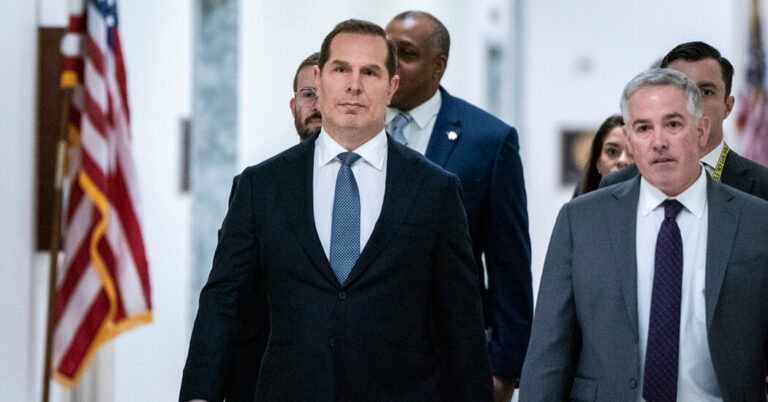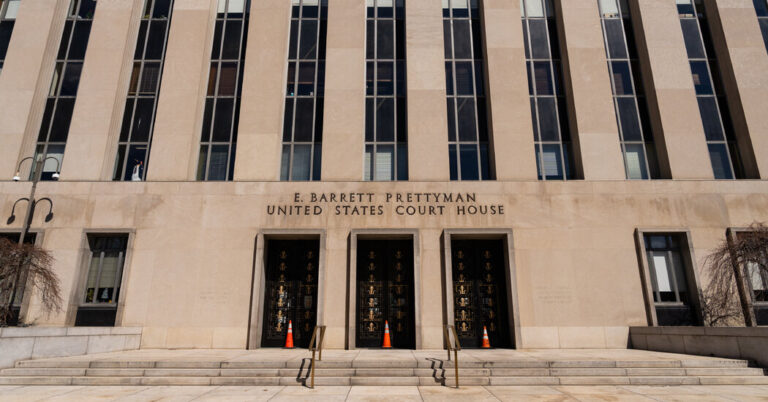Pete Marocco, who worked with Elon Musk’s team to oversee the gutting of foreign aid and the dismantling of the main U.S. aid agency, has left the State Department, administration officials said on Monday.
The abrupt departure comes in the middle of the department’s efforts to merge the remnants of that aid group, the U.S. Agency for International Development, into the department by mid-August.
Mr. Marocco had been acting as the head of foreign aid at the department and would have overseen the remaining aid operations, which amount to only a fraction of those active before President Trump took office.
Mr. Marocco is expected to take another job in the administration, U.S. officials say.
The State Department did not provide official comment on Mr. Marocco’s departure. But a statement from the department’s press office that was attributed to a “senior administration official” praised Mr. Marocco for finding “egregious abuses of taxpayer dollars” during his tenure. The statement provided no examples of such abuses.
Mr. Marocco’s critics said they planned to continue scrutinizing how he and Secretary of State Marco Rubio have gutted foreign aid.
“Pete Marocco’s tenure brought chaos to U.S.A.I.D., reckless and unlawful policy to the State Department, and dismantled longstanding U.S. foreign policy,” Senator Brian Schatz, Democrat of Hawaii, said in a statement, adding, “His actions deprived millions of people around the world of lifesaving aid and jeopardized U.S. credibility with our partners.”
Mr. Marocco took a senior post in the State Department in late January to oversee foreign aid. After Mr. Rubio was named the acting administrator of U.S.A.I.D. on Feb. 3, he appointed Mr. Marocco acting deputy of the agency. Mr. Rubio has publicly defended the cuts to foreign aid, saying they have been necessary to rein in an overly expansive use of aid.
Mr. Marocco left the deputy role last month, and his duties were taken over by Jeremy Lewin, a 28-year-old employee of the government-cutting task force headed by Mr. Musk, the billionaire adviser to Mr. Trump. Mr. Marocco and members Mr. Musk’s team entered the headquarters of U.S.A.I.D. in late January to take apart the technical infrastructure of the agency, and Mr. Musk later called it a “criminal organization” on social media.
In recent weeks, some U.S. officials have talked about severe tensions between Mr. Marocco and senior colleagues, including ones in top offices at the department.
But Mr. Rubio has approved all the foreign aid cuts. He announced in early March that he and Mr. Musk’s team had cut more than 83 percent of U.S.A.I.D.’s programs that had been active under 5,200 contracts. A vast majority of the agency’s 10,000 employees have been fired.
The New York Times reported last month that the cuts had gutted U.S.A.I.D. operations to such a degree that the agency had struggled to muster a response to a devastating earthquake in Myanmar, while China, Russia and other nations had sent teams immediately. After a three-person team of U.S.A.I.D. workers finally arrived in the country, they got emails saying they were being fired.
Mr. Marocco and other officials have also ended contracts that some aid agency employees had thought would be preserved. In a round of cuts early this month, Mr. Marocco and other State Department officials ended all U.S. humanitarian aid to Afghanistan and Yemen, where millions of people are suffering from a lack of food. Contracts for food aid to Niger and the Democratic Republic of Congo were also cut, as well as other programs helping about a dozen nations.
Mr. Marocco also met with an official from the government of Viktor Orban, Hungary’s authoritarian leader, and promised to halt all aid programs that “intervened” in the country’s internal affairs, according to statements released by the official, Tristan Azbej.
The Wall Street Journal reported on Sunday that Mr. Marocco had left the State Department.
Mr. Marocco worked at U.S.A.I.D. briefly during the first Trump administration, as well as at the State Department and the Pentagon. Employees at the aid agency filed a 13-page memo in September 2020 accusing Mr. Marocco of mismanagement. “Intervention is urgently needed,” it said.
In 2018, while working at the State Department as a political appointee, Mr. Marocco secretly met in the Balkans with ethnonationalist Bosnian Serb separatist leaders, whom the department had deemed off limits, according to a ProPublica report. The U.S. ambassador to Bosnia and Herzegovina rebuked Mr. Marocco. That rebuke was confirmed to The Times by a U.S. official.
A group of investigators has stated publicly that Mr. Marocco and his wife, Merritt Corrigan, who was also an appointee at U.S.A.I.D. during the first Trump administration, are in a photo of people who entered the Capitol on Jan. 6, 2021. Neither was charged, and neither has confirmed being at the building that day.
The State Department has not replied with any public comments to various email requests sent since late January about Mr. Marocco’s activities since the first Trump administration.












